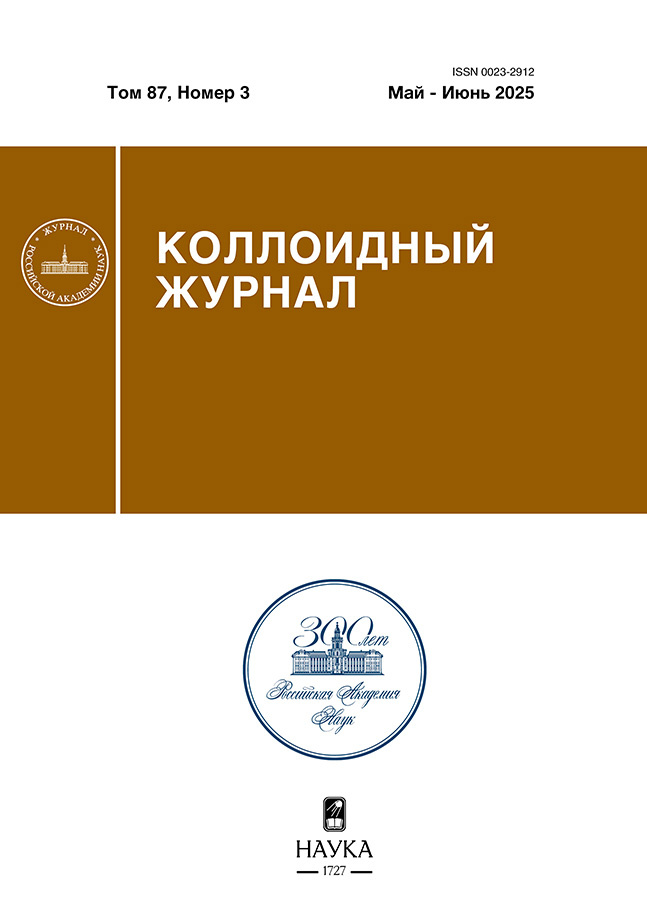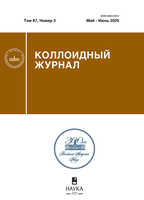Коллоидный журнал
Публикуются оригинальные экспериментальные и теоретические работы и обзорные статьи в области науки о коллоидах и поверхностных явлениях.
Журнал является рецензируемым, входит в Перечень ВАК для опубликования работ соискателей ученых степеней, включен в крупнейшие международные базы данных Web of Science и Scopus, а также в систему РИНЦ.
Журнал основан в 1935 году.
Свидетельство о регистрации СМИ: № 0110217 от 08.02.1993
Учредители: Российская Академия наук, Институт физической химии РАН
Главный редактор: Бойнович Людмила Борисовна, академик РАН, д.ф.-м.н.
Периодичность / доступ: 6 выпусков в год / подписка
Входит в: Белый список (2 уровень), перечень ВАК, РИНЦ
Текущий выпуск
Том 87, № 3 (2025)
- Год: 2025
- Выпуск опубликован: 04.09.2025
- Статей: 8
- URL: https://www.clinpractice.ru/0023-2912/issue/view/13651
Статьи
Оптически активные пленки на основе органозоля серебра, стабилизированного АОТ
Аннотация
Методом погружения на полистирольной подложке получены композитные пленки на основе органозоля серебра, стабилизированного анионным ПАВ (АОТ, бис(2-этилгексил)сульфосукцинатом натрия). Показано, что формирование пленок сопровождается образованием цепочечных агрегатов серебра с межчастичным расстоянием больше диаметров частиц. При этом образование агрегатов не изменяет оптические свойства наночастиц. Полученные пленки демонстрируют сигнал плазмонного поглощения, и отсутствует делокализация плазмонов. Установлено, что варьирование числа погружений подложки в золь позволяет влиять на интенсивность сигнала плазмонного поглощения, а также функциональные свойства конечных покрытий: морфологию, шероховатость (от 9 ± 2 до 25 ± 4 нм), толщину (от 585 ± 13 до 831 ± 28 нм) и смачиваемость поверхности водой (от 36 ± 6 до 53 ± 9°).
 173-186
173-186


Применение машинного обучения для предсказания фазового поведения интерполиэлектролитных комплексов в водно-солевых средах
Аннотация
Водно-солевые растворы интерполиэлектролитных комплексов (ИПЭК) представляют собой классический пример «умных» систем, фазовое равновесие в которых регулируется множеством факторов, связанных как с параметрами полимерных компонентов, так и с физическими и химическими свойствами среды. В данной работе представлена модель, созданная на основе машинного обучения, для прогнозирования области существования водорастворимых ИПЭК. Предложен подход независимого учета физико-химических свойств полиэлектролитов и свойств среды. Разработанная модель универсальна и может быть использована для прогнозирования свойств многокомпонентных систем различной химической природы.
 187-201
187-201


Изучение криоструктурирования полимерных систем. 69. Физико-механические и теплофизические свойства криогелей поливинилового спирта, сформированных в присутствии непротонированной и солевой форм оснóвных α-аминокислот
Аннотация
Путем замораживания при –20°С в течение 12 ч и затем размораживание нагреванием со скоростью 0.03°С/мин водных растворов поливинилового спирта (ПВС) без и с 0.1–0.5 моль/л добавками оснóвных α-аминокислот (аргинин, гистидин, лизин, орнитин) в непротонированной или солевой формах получены макропористые физические (нековалентные) криогели и исследовано влияние таких добавок на физико-химические свойства сформированных таким образом гелевых материалов. Показано, что в отношении криотропного гелеобразования ПВС добавки аргинина, его гидрохлорида и гистидина из-за противодействия водородному связыванию проявляют хаотропную активность, приводя к снижению упругости и теплостойкости получаемых криогелей, тогда как добавки лизина, орнитина и их гидрохлоридов, а также солянокислой соли гистидина, благодаря промотированию водородного связывания действуют как космотропные агенты, вызывая возрастание компрессионного модуля упругости и повышение температуры плавления образцов. Изучение кинетики высвобождения использованных в работе аминокислотных добавок показало, что релиз гидрохлоридов из гелевого носителя во внешнее водное окружение происходил несколько медленнее, чем непротонированных форм, но во всех случаях без существенных диффузионных затруднений. Учитывая, что такие аминокислоты используются в косметологии, полученные в данном исследовании результаты позволяют полагать, что нагруженные аминокислотными добавками криогели ПВС могут представлять практический интерес при разработке носителей косметических средств типа питательных масок, покрытий на проблемные участки кожи, «патчей» и др.
 202-222
202-222


Супергидрофобное покрытие на основе эпоксидной эмали ЭП-140: исследование механической стойкости при внешних воздействиях
Аннотация
В данной работе исследована механическая стойкость супергидрофобного покрытия, созданного на основе промышленной эпоксидной эмали ЭП-140. Для достижения супергидрофобного состояния нанесенное покрытие модифицировали методом импульсного лазерного текстурирования и хемосорбции фторсилана. Целью исследования была оценка устойчивости покрытия к различным механическим воздействиям, характерным для эксплуатации в открытой атмосфере: длительному контакту с водой, воздействию высокоскоростной струи воды, абразивному износу падающим песком и многократному отрыву липкой ленты. Показано, что комбинированный подход, используемый при супергидрофобизации, обеспечивает не только высокие водоотталкивающие свойства, но и значительную устойчивость к деградации. Так, эксперименты выявили лишь незначительное снижение характеристик смачивания при сохранении гетерогенного режима смачивания, что подтверждает сохранение функциональности покрытия даже при экстремальных механических воздействиях. Полученные данные указывают на перспективность применения разработанного покрытия в промышленности, где требуется сочетание высокой износостойкости и экономической эффективности.
 223-232
223-232


Процессы структурообразования в водных растворах поливинилового спирта при его облучении вакуумным ультрафиолетом
Аннотация
При облучении 5% водного раствора поливинилового спирта вакуумным ультрафиолетовым излучением (ВУФ) с длиной волны 172 нм обнаружено, что происходит изменение структуры раствора с образованием сшитых фрагментов полимера, невзирая на то, что глубина проникновения ВУФ в раствор является незначительной.
 233-239
233-239


Превращение водного раствора метилметакрилата в стабильный монодисперсный латекс путем инициирования полимеризации системой гидрохинон–персульфат калия
Аннотация
Целью данной работы было выявление возможностей синтеза стабильного латекса с узким распределением частиц путем гомогенной полимеризации в водном растворе метилметакрилата. Впервые проведена полимеризация метилметакрилата в статических условиях в водном растворе окислительно-восстановительной системы гидрохинон–персульфат калия. Предполагалось, что образующиеся на промежуточной стадии окисления гидрохинона семихиноновые анион-радикалы могут участвовать в реакциях обрыва растущих радикалов и, изменяя параметры полимерных молекул, влиять на процесс формирования латексных частиц. В статье представлены результаты исследования коллоидных параметров полученного латекса, которые показывают, что выбранные условия полимеризации позволяют воспроизводимо синтезировать монодисперсный стабильный латекс.
 240-245
240-245


Развитие исследований графеновых наножидкостей в качестве теплоносителей в солнечных коллекторах прямого поглощения
Аннотация
В данной работе рассмотрен потенциал применения графеновой наножидкости в качестве теплоносителя в солнечных коллекторах прямого поглощения. В результате выявлено, что графеновая наножидкость обладает превосходной поглощающей способностью при взаимодействии с монохроматическим (520 нм) и инфракрасным излучением ближней области. Применение в качестве рабочей жидкости графеновой наножидкости по сравнению с дистиллированной водой в солнечном коллекторе прямого поглощения увеличило его эффективность даже при очень низкой концентрации частиц дисперсной фазы. Однако для того, чтобы применить графеновую наножидкость в энергетических системах в качестве рабочей жидкости, необходимо решить некоторые вопросы, в первую очередь связанные с ее невысокой стабильностью и термической неустойчивостью.
 246-260
246-260


Исследование межфазных процессов между нефтью и интенсифицирующими жидкостями в разных условиях контакта
Аннотация
Одной из практических проблем нефтегазовой отрасли является образование нефтекислотных эмульсий и асфальтенового шлама при контакте интенсифицирующих составов и нефти. Ключом к решению этих проблем является понимание межфазных процессов на границе раздела фаз между нефтью и составами, качественному исследованию которых и посвящена данная работа. Исследуются процессы, происходящие между чувствительной нефтью и двумя видами интенсифицирующих составов – на основе соляной кислоты и этилендиамитетрауксусной кислоты (ЭДТА) с добавлением и без добавления поверхностно-активного вещества (ПАВ). Используются три метода – простое перемешивание («bottle-test»), совместное течение жидкостей в капилляре, совместное течение жидкостей в микромодели, имитирующей пористую среду. С помощью простого перемешивания показано, что введение ПАВ в 15% соляную кислоту может предотвратить образование шлама, но не предотвращает образование эмульсии. Кроме того, обнаружено, что составы на основе ЭДТА с нейтральным pH совместимы даже с чувствительной нефтью. С помощью совместного течения продемонстрирована роль стенок капилляра в образовании асфальтенового шлама, а также отмывающая способность хелатного состава. Совместное течение жидкостей в миромодели демонстрирует особенности соляной кислоты по сравнению с хелатом – дискретное течение, образование эмульсии в пристеночном слое, образование осадка на стенках пор. Результаты данной работы могут быть полезны как для дальнейшего фундаментального исследования коллоидно-химических процессов в нефтяном пласте, так и для практического применения.
 261-274
261-274













